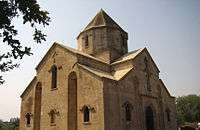Grigoris (catholicos)
Grigoris (early fourth century AD, Caesaria Mazaca, Roman Empire – ca. 330 AD, Vatnik Valley, near present-day Derbent, Russia) was the Catholicos of the Church of Caucasian Albania ca. 325–330 AD. He is considered a saint martyr by the Armenian Apostolic Church.
Life
Grigoris was born in Caesaria, Cappadocia and was the grandson of Gregory the Illuminator an originally Parthian Christian missionary who converted the Armenian king to Christianity and became the first official governor of the Armenian Apostolic Church. In addition, both Grigoris' father Vrtanes, and brother Husik, were consecutive catholicoi of Armenia.[1]
By 325, Christianity in Armenia had gained strength and Armenian religious leaders went on to proselytise the neighbouring states. According to the tenth-century author Movses Kaghankatvatsi, Gregory the Illuminator left Armenia to spread Christianity in Caucasian Albania, where on his orders there was built a church later to become the Amaras Monastery. He then ordained his grandson Grigoris, at the time only 15 years old, to become the patriarch of the Church of Caucasian Albania.[2] The growing influence of Christianity and the Armenian Church greatly worried rulers of the neighbouring pagan principalities, who were unwilling to embrace the new religion. According to Faustus Byuzand, when Grigoris arrived in the Caucasian Albanian principality of Massagetae (located along the northeastern shore of the present day Republic of Azerbaijan and south Dagestani shore of the Caspian Sea) to preach Christianity, its ruler Sanatruk (also known as Sanesan) of the local branch of Arsacides ordered him killed. Grigoris was trampled to death by mounted Massagetae soldiers in the Vatnik Valley, near the present-day village of Nughdi 37 kilometres south of Derbent.[3]
Grigoris' body was taken to the Amaras Monastery and buried in an unknown location. In 489, Vachagan III the Pious, King of Caucasian Albania, recovered Grigoris' relics and buried them in a tomb within the Amaras Monastery. Grigoris' place of death in Nughdi was marked by the construction of a chapel at an unknown date, later rebuilt into a church, and venerated by local Christians and Muslims alike.[4]
References
- René Grousset: Histoire de l´Arménie, Payot, Paris, 1973, S. 130.
- P'awstos Byuzand. The Epic Histories Attributed to P'awstos Buzand, English transl. by N. Garsoian, Cambridge, Massachusetts, 1983. IV.50; V.12.
- René Grousset, op. cit. S. 130
- Dmitri Gevorkyan. Temple at the Source of Our Faith. Noev Kovcheg, #157. 10 October 2010. Retrieved 25 July 2012.
